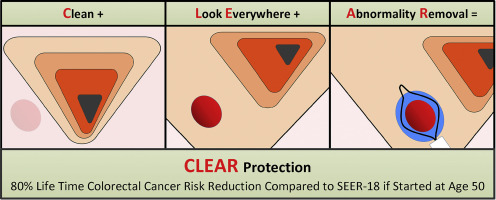当前位置:
X-MOL 学术
›
Gastrointest. Endosc.
›
论文详情
Our official English website, www.x-mol.net, welcomes your
feedback! (Note: you will need to create a separate account there.)
Colorectal cancer prevention by a CLEAR principles-based colonoscopy protocol: an observational study.
Gastrointestinal Endoscopy ( IF 6.7 ) Pub Date : 2019-12-07 , DOI: 10.1016/j.gie.2019.11.043 Sudha Xirasagar 1 , Yuqi Wu 1 , Meng-Han Tsai 2 , Jiajia Zhang 1 , Stephanie Chiodini 3 , Piet C de Groen 4
Gastrointestinal Endoscopy ( IF 6.7 ) Pub Date : 2019-12-07 , DOI: 10.1016/j.gie.2019.11.043 Sudha Xirasagar 1 , Yuqi Wu 1 , Meng-Han Tsai 2 , Jiajia Zhang 1 , Stephanie Chiodini 3 , Piet C de Groen 4
Affiliation

|
BACKGROUND AND AIMS
Colorectal cancer (CRC) prevention by colonoscopy has been lower than expected. We studied CRC prevention outcomes of a colonoscopy protocol based on Clean the colon, Look Everywhere, and complete Abnormality Removal (CLEAR) principles.
METHODS
This observational follow-up study studied patients provided screening colonoscopy at a free-standing private ambulatory surgery center in South Carolina by 80 endoscopists from October 2001 to December 2014, followed through December 2015. The colonoscopy protocol, optimized for polyp clearance, featured in-person bowel preparation instructions reinforced by phone, polyp search and removal throughout insertion and gradual withdrawal with circumferential tip movements, and a team approach using all personnel present to maximize polyp detection, patient safety, and clear-margin polypectomy including requesting repeat inspection or additional tissue removal. Outcome measures were postscreening lifetime CRC risk relative to Surveillance Epidemiology and End Results (SEER)-18 and interval cancer rate (postcolonoscopy CRCs among cancer-free patients at screening).
RESULTS
Of 25,862 patients (mean age, 58.1 years; 52% black; 205,522 person-years of observation), 159 had CRC at screening and 67 patients developed interval CRC. The interval CRC rate was 3.34 per 10,000 person-years of observation, 5.79 and 2.24 among patients with and without adenomas, respectively. The rate was similar among older patients (mean age 68.5 years at screening) and with prolonged follow-up. Postscreening lifetime CRC risk was 1.6% (bootstrap 95% confidence interval, 1.3%-1.8%) versus 4.7% in SEER-18, 67% lower. Subgroups with mean screening ages of 50 and 68.5 years showed risk reductions of 80% and 72%, respectively. The adverse event rate was less than usually reported rates: perforation 2.6 per 10,000, bleeding with hospitalization 2.4 per 10,000, and no deaths.
CONCLUSIONS
A colonoscopy protocol optimized for polyp clearance prevented 67% of CRC compared with a SEER-18 population given ongoing population screening.
中文翻译:

通过基于 CLEAR 原则的结肠镜检查方案预防结直肠癌:一项观察性研究。
背景和目的 通过结肠镜检查预防结直肠癌 (CRC) 的效果低于预期。我们研究了基于清洁结肠、无处不在和完整异常去除 (CLEAR) 原则的结肠镜检查方案的 CRC 预防结果。方法 这项观察性随访研究研究了 2001 年 10 月至 2014 年 12 月期间,由 80 名内窥镜医师在南卡罗来纳州一家独立的私人门诊手术中心对患者进行的结肠镜筛查,随访直至 2015 年 12 月。结肠镜检查方案针对息肉清除进行了优化,其特点是-通过电话强化人员肠道准备指示、在插入过程中进行息肉搜索和切除以及通过尖端圆周运动逐渐退出,以及使用所有在场人员的团队方法来最大限度地提高息肉检测、患者安全和清晰边缘息肉切除术,包括要求重复检查或额外检查组织去除。结果指标是相对于流行病学监测和最终结果 (SEER)-18 的筛查后终生 CRC 风险和间期癌症发生率(筛查时无癌症患者的结肠镜检查后 CRC)。结果 在 25,862 名患者(平均年龄 58.1 岁;52% 黑人;205,522 人年观察)中,159 名患者在筛查时患有 CRC,67 名患者发展为间期 CRC。每 10,000 人年观察中,间隔 CRC 发生率为 3.34 例,有腺瘤患者和无腺瘤患者分别为 5.79 例和 2.24 例。在老年患者(筛查时平均年龄 68.5 岁)和长期随访中,该比率相似。筛查后终生 CRC 风险为 1.6%(引导 95% 置信区间,1.3%-1.8%),而 SEER-18 为 4.7%,低 67%。平均筛查年龄为 50 岁和 68.5 岁的亚组的风险分别降低了 80% 和 72%。 不良事件发生率低于通常报告的发生率:每 10,000 人中发生穿孔 2.6 例,每 10,000 人中发生出血 2.4 例,无死亡。结论 与正在进行的人群筛查的 SEER-18 人群相比,针对息肉清除进行优化的结肠镜检查方案可预防 67% 的 CRC。
更新日期:2019-12-07
中文翻译:

通过基于 CLEAR 原则的结肠镜检查方案预防结直肠癌:一项观察性研究。
背景和目的 通过结肠镜检查预防结直肠癌 (CRC) 的效果低于预期。我们研究了基于清洁结肠、无处不在和完整异常去除 (CLEAR) 原则的结肠镜检查方案的 CRC 预防结果。方法 这项观察性随访研究研究了 2001 年 10 月至 2014 年 12 月期间,由 80 名内窥镜医师在南卡罗来纳州一家独立的私人门诊手术中心对患者进行的结肠镜筛查,随访直至 2015 年 12 月。结肠镜检查方案针对息肉清除进行了优化,其特点是-通过电话强化人员肠道准备指示、在插入过程中进行息肉搜索和切除以及通过尖端圆周运动逐渐退出,以及使用所有在场人员的团队方法来最大限度地提高息肉检测、患者安全和清晰边缘息肉切除术,包括要求重复检查或额外检查组织去除。结果指标是相对于流行病学监测和最终结果 (SEER)-18 的筛查后终生 CRC 风险和间期癌症发生率(筛查时无癌症患者的结肠镜检查后 CRC)。结果 在 25,862 名患者(平均年龄 58.1 岁;52% 黑人;205,522 人年观察)中,159 名患者在筛查时患有 CRC,67 名患者发展为间期 CRC。每 10,000 人年观察中,间隔 CRC 发生率为 3.34 例,有腺瘤患者和无腺瘤患者分别为 5.79 例和 2.24 例。在老年患者(筛查时平均年龄 68.5 岁)和长期随访中,该比率相似。筛查后终生 CRC 风险为 1.6%(引导 95% 置信区间,1.3%-1.8%),而 SEER-18 为 4.7%,低 67%。平均筛查年龄为 50 岁和 68.5 岁的亚组的风险分别降低了 80% 和 72%。 不良事件发生率低于通常报告的发生率:每 10,000 人中发生穿孔 2.6 例,每 10,000 人中发生出血 2.4 例,无死亡。结论 与正在进行的人群筛查的 SEER-18 人群相比,针对息肉清除进行优化的结肠镜检查方案可预防 67% 的 CRC。










































 京公网安备 11010802027423号
京公网安备 11010802027423号